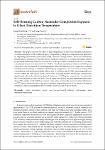Self-Sensing Carbon Nanotube Composites Exposed to Glass Transition Temperature
| dc.contributor.author | Jang, S-H | |
| dc.contributor.author | Li, L-Y | |
| dc.date.accessioned | 2023-11-28T13:22:16Z | |
| dc.date.available | 2023-11-28T13:22:16Z | |
| dc.date.issued | 2020 | |
| dc.identifier.issn | 1996-1944 | |
| dc.identifier.issn | 1996-1944 | |
| dc.identifier.other | 259 | |
| dc.identifier.uri | https://pearl.plymouth.ac.uk/handle/10026.1/21743 | |
| dc.description.abstract |
<jats:p>This paper reported the effect of high temperature on the electro-mechanical behavior of carbon nanotube (CNT) reinforced epoxy composites. CNT/epoxy composites were fabricated by dispersing CNTs in the epoxy matrix using a solution casting method. Electrical conductivity measurements obtained for the CNT/epoxy composites indicated a steadily increasing directly proportional relationship with CNT concentration with a percolation threshold at 0.25 wt %, reaching a maximum of up to 0.01 S/m at 2.00 wt % CNTs. The electro-mechanical behavior of CNT/epoxy composites were investigated at a room temperature under the static and cyclic compressive loadings, resulting that the change in resistance of CNT/epoxy composites was reduced as increasing CNT concentration with good repeatability. This is due to well-networked CNTs conducting pathways created within the solid epoxy matrix observed by scanning electron microscopy. Temperature significantly affects the electro-mechanical behavior of CNT/epoxy composites. In particular, the electro-mechanical behavior of CNT/epoxy composites below the glass transition temperature showed the similar trend with those at room temperature, whereas the electro-mechanical behavior of CNT/epoxy composites above the glass transition temperature showed an opposite change in resistance with poor repeatability due to unstable CNT network in epoxy matrix.</jats:p> | |
| dc.format.extent | 259-259 | |
| dc.format.medium | Electronic | |
| dc.language | en | |
| dc.publisher | MDPI AG | |
| dc.subject | carbon nanotubes | |
| dc.subject | epoxy | |
| dc.subject | electrical-mechanical behavior | |
| dc.subject | self-sensing | |
| dc.subject | glass transition temperature | |
| dc.title | Self-Sensing Carbon Nanotube Composites Exposed to Glass Transition Temperature | |
| dc.type | journal-article | |
| dc.type | Article | |
| plymouth.author-url | https://www.ncbi.nlm.nih.gov/pubmed/31936072 | |
| plymouth.issue | 2 | |
| plymouth.volume | 13 | |
| plymouth.publication-status | Published online | |
| plymouth.journal | Materials | |
| dc.identifier.doi | 10.3390/ma13020259 | |
| plymouth.organisational-group | |Plymouth | |
| plymouth.organisational-group | |Plymouth|Research Groups | |
| plymouth.organisational-group | |Plymouth|Faculty of Science and Engineering | |
| plymouth.organisational-group | |Plymouth|Faculty of Science and Engineering|School of Engineering, Computing and Mathematics | |
| plymouth.organisational-group | |Plymouth|Research Groups|Marine Institute | |
| plymouth.organisational-group | |Plymouth|REF 2021 Researchers by UoA | |
| plymouth.organisational-group | |Plymouth|Users by role | |
| plymouth.organisational-group | |Plymouth|Users by role|Academics | |
| plymouth.organisational-group | |Plymouth|REF 2021 Researchers by UoA|UoA12 Engineering | |
| plymouth.organisational-group | |Plymouth|REF 2028 Researchers by UoA | |
| plymouth.organisational-group | |Plymouth|REF 2028 Researchers by UoA|UoA12 Engineering | |
| dc.publisher.place | Switzerland | |
| dcterms.dateAccepted | 2020-01-06 | |
| dc.date.updated | 2023-11-28T13:22:15Z | |
| dc.rights.embargodate | 2023-12-6 | |
| dc.identifier.eissn | 1996-1944 | |
| dc.rights.embargoperiod | ||
| rioxxterms.versionofrecord | 10.3390/ma13020259 |


